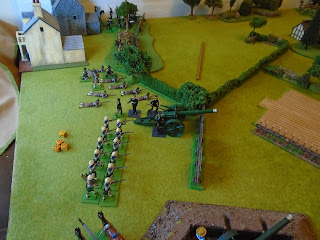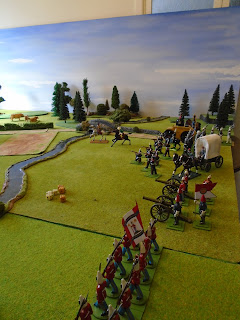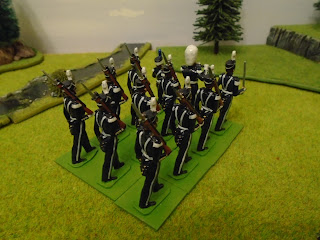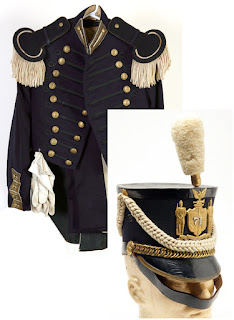Just completed a new battalion for my British Victorian Army c1900. Working through my spares box, and with reinforcements kindly furnished by Paul Watson, I was able to muster twelve suitable castings for the Scots Guards. With the arrival of rifle-arms from REPLICA, the restoration could begin. To be honest, I already had this regiment in my collection, but had dispatched the painted herald figures off to a relation, for his budding collection.
Wednesday, 30 March 2022
Scots Guards Completed (And State of my Spares Box)
Friday, 25 March 2022
WOODEN TOY TANKS and early TIN examples
Have seen other blogs upload photos of their toy tanks made of wood. Several designs/kits are available to purchase from the Tank Museum website. And they aren't too expensive. Depending on the time and effort you put into painting them, they really do look quite good. As I'm seriously looking at the prospect of constructing one of my own, to a scale and design I prefer, thought the following might prove of interest. Here are some photos of old home-made tanks made of wood. Most of these certainly date back to the Second World War when metal toy production was prohibited. I'm impressed by tank no.2, with its turret-gun system.
1. Simple idea, could be developed.
Saturday, 19 March 2022
NEW ADDITIONS, March 19
Several years ago I purchased a music box biscuit tin for Christmas. It cost £5 and included a pack of shortbread biscuits. The Swiss mechanism plays, rather quaintly, DECK THE HALLS with Holly. With hindsight, it wasn't that great looking, and recently decided to get rid of it. Change of plan, decided to see if it could be converted into something more attractive.
Completed yesterday, here it is. I'm a lot happier with it, and the tin container can also store some walls, railings, and street lamps. And the music only adds to my old style 'Toyshop Atmosphere'.
Monday, 14 March 2022
The St.Eugene Wargame & Skirmish
Although the 1st Canadian Army, holding the Granby Line, had been forced to withdraw to Montreal (see previous game), intelligence in Montreal (D5) was informed that the 2nd Army of New York had suffered heavy losses, and would require some time to reform and build up their strength. Empire Command decided to inspect the Granby survivors, and three battalions (D4-6) were willing to immediately move off to support the western defences (the St-Eugene Line) to oppose the American Main Army. Dice were thrown to determine whether they would arrive there before the American assault. Scoring a D3, compared to a D6, they arrived in good time........ General Gordon embraced the Canadian commander on their most opportune arrival.
So what of the Americans. Their command had also been informed on the action at Granby (D6), that a headlong rush towards Montreal by their Main Army was no longer required. Instead, they informed other garrisons to furnish additional troops and artillery. The new plan was to bombard the St-Eugene Line into submission. This would also allow the 2nd Army of New York time to reconstitute itself.
Reinforcements Arrive!
The response to the Main Army was quick and efficient. By utilising the canal systems joining the Great Lakes, merchant shipping ferried three military units from Detroit, and one from Buffalo, NY, to Ottawa in record time.
The American garrison in Ottawa had already prepared to move their siege guns, in preparation for Montreal, now they would form part of the 'Liberty Line' (entrenchments being raised opposite the St.Eugene Line).
Reinforcements arrive!
The American delay in attacking the St.Eugene Line had allowed a naval vessel to arrive from Quebec (D4). It now disembarked a naval landing party and gun, That city was unable to send further reinforcements as its garrison only comprised two more military units, and some armed civilians, but the extra gun was most welcome.
STATE OF THE LINES The Liberty Line. Fifteen military units including the Signals Corps. Four siege guns, three field guns. Note, field guns are not in range. Also, two of the siege guns are actually howitzers, so any redoubt casualties cannot claim saving throws for hard cover!
The St.Eugene Line. Ten military units, including 3 siege, 3 field guns. By mutual agreement. The civilian population, and their livestock, were granted leave to vacate the area.
The Advance on Montreal (Wargame)
Saturday, 12 March 2022
New York National Guard (71st Battalion)
Decided to home-cast a new battalion for my late 19th Century American army. Some of the New York National Guard uniforms were quite distinctive, so here is my rendition of the 71st Battalion. I have quite a few sources for their uniform and as they all differ its fair to say the period 1870-1910 allowed commanders quite a lot of leeway as to the cut and style of their dress uniform.
This white hat belonged to the 14th U.S. Army Regiment, probably a musician, thought it would look good with this unit. The fifer was drafted from my spares box, white bearskins were also popular with National Guard units.









%20copy.JPG)



















































